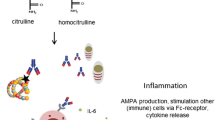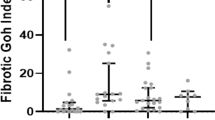Abstract
Background
The alternative pathway of the complement system is known to play a role in the generation of asthmatic airway inflammation, but its regulatory complement protein, factor H has not been investigated in this disease.
Purpose
Our aim was to determine the local bronchial complement factor H (CFH) levels in asthma, and to investigate its relationship with complement activation, systemic CFH concentrations and clinical characteristics of patients.
Methods
Induced sputum and plasma were collected from 21 healthy and 26 asthmatic subjects, and complement factor H and SC5b-9 concentrations were assessed by ELISA. Total protein concentrations were determined by biuret-reaction based microassay system from induced sputa.
Results
CFH was detectable in 81 % of healthy and 100 % of asthmatic subjects, while SC5b-9 exceeded the detection limit in 62 % of healthy subjects and 85 % of asthmatic patients. Sputum CFH concentrations and CFH/protein ratios were increased in samples from asthmatic patients, and correlated with loss of lung function, asthma control, severity and medication intensity, but not with plasma CFH concentrations. Sputum CFH/protein ratios were in positive correlation also with sputum eosinophilic cell counts in asthma. SC5b-9 concentrations were not higher in the asthmatic sputa, although they correlated with sputum CFH concentrations.
Conclusions
CFH level is elevated on asthmatic airway surface, and may be associated with uncontrolled inflammation in asthma.



Similar content being viewed by others
Abbreviations
- C:
-
Complement
- CFH:
-
Complement factor H
- FVC:
-
Forced vital capacity
- FENO:
-
Fractional exhaled nitric oxide
- FEF 25–75:
-
Forced expiratory flow at 25–75 percentage of FVC
- FEV1 :
-
Forced expiratory volume in one second
- GINA:
-
Global initiative for asthma
- ICS:
-
Inhaled corticosteroid
- IQR:
-
Interquartile range
- MEF 50:
-
Maximal instantaneous forced expiratory flow where 50 % of the FVC remains to be expired
- MEF 75:
-
Maximal instantaneous forced expiratory flow where 75 % of the FVC remains to be expired
- PEF:
-
Peak expiratory flow
References
Jatakanon A, Lim S, Barnes PJ. Changes in sputum eosinophils predict loss of asthma control. Am J Respir Crit Care Med. 2000;161:64–72.
Hastie AT, Moore WC, Meyers DA, Vestal PL, Li H, Peters SP, Bleecker ER, National Heart, Lung, and Blood Institute Severe Asthma Research Program. Analyses of asthma severity phenotypes and inflammatory proteins in subjects stratified by sputum granulocytes. J Allergy Clin Immunol. 2010;125:1028–1036.e13.
Bowser C, Erstein DP, Silverberg JI, Nowakowski M, Joks R. Correlation of plasma complement split product levels with allergic respiratory disease activity and relation to allergen immunotherapy. Ann Allergy Asthma Immunol. 2010;104:42–9.
Nakano Y, Morita S, Kawamoto A, Suda T, Chida K, Nakamura H. Elevated complement C3a in plasma from patients with severe acute asthma. J Allergy Clin Immunol. 2003;112:525–30.
Marc MM, Korosec P, Kosnik M, Kern I, Flezar M, Suskovic S, Sorli J. Complement factors c3a, c4a, and c5a in chronic obstructive pulmonary disease and asthma. Am J Respir Cell Mol Biol. 2004;31:216–9.
Krug N, Tschernig T, Erpenbeck VJ, Hohlfeld JM, Köhl J. Complement factors C3a and C5a are increased in bronchoalveolar lavage fluid after segmental allergen provocation in subjects with asthma. Am J Respir Crit Care Med. 2001;164:1841–3.
Taube C, Thurman JM, Takeda K, Joetham A, Miyahara N, Carroll MC, Dakhama A, Giclas PC, Holers VM, Gelfand EW. Factor B of the alternative complement pathway regulates development of airway hyperresponsiveness and inflammation. Proc Natl Acad Sci USA. 2006;103:8084–9.
Józsi M, Manuelian T, Heinen S, Oppermann M, Zipfel PF. Attachment of the soluble complement regulator factor H to cell and tissue surfaces: relevance for pathology. Histol Histopathol. 2004;19:251–8.
Ferreira VP, Pangburn MK, Cortés C. Complement control protein factor H: the good, the bad, and the inadequate. Mol Immunol. 2010;47:2187–97.
Pio R, Garcia J, Corrales L, Ajona D, Fleischhacker M, Pajares MJ, Cardenal F, Seijo L, Zulueta JJ, Nadal E, Witt C, Lozano MD, Schmidt B, Montuenga LM. Complement factor H is elevated in bronchoalveolar lavage fluid and sputum from patients with lung cancer. Cancer Epidemiol Biomarkers Prev. 2010;19:2665–72.
Spanevello A, Migliori GB, Sharara A, Ballardini L, Bridge P, Pisati P, Neri M, Ind PW. Induced sputum to assess airway inflammation: a study of reproducibility. Clin Exp Allergy. 1997;27:1138–44.
Spanevello A, Confalonieri M, Sulotto F, Romano F, Balzano G, Migliori GB, Bianchi A, Michetti G. Induced sputum cellularity. Reference values and distribution in normal volunteers. Am J Respir Crit Care Med. 2000;162:1172–4.
Jayaram L, Pizzichini MM, Cook RJ, Boulet LP, Lemière C, Pizzichini E, Cartier A, Hussack P, Goldsmith CH, Laviolette M, Parameswaran K, Hargreave FE. Determining asthma treatment by monitoring sputum cell counts: effect on exacerbations. Eur Respir J. 2006;27:483–94.
Malerba M, Ragnoli B, Radaeli A, Tantucci C. Usefulness of exhaled nitric oxide and sputum eosinophils nt he long-term control of eosinophilic asthma. Chest. 2008;134:733–9.
Bakakos P, Schleich F, Alchanatis M, Louis R. Induced sputum in asthma: from bench to bedside. Curr Med Chem. 2011;18:1415–22.
Global Strategy for Asthma Management and Prevention, Global Initiative for Asthma (GINA) 2011. Available from: http://www.ginasthma.org/
Dweik RA, Boggs PB, Erzurum SC, Irvin CG, Leigh MW, Lundberg JO, Olin A-C, Plummer AL. D. Robin Taylor, and on behalf of the American Thoracic Society Committee on Interpretation of Exhaled Nitric Oxide Levels (FENO) for Clinical Applications. An Official ATS Clinical Practice Guideline: Interpretation of Exhaled Nitric Oxide Levels (FENO) for Clinical Applications. Am J Respir Crit Care Med. 2011;184:602–15.
Miller MR, Hankinson J, Brusasco V, Burgos F, Casaburi R, Coates A, Crapo R, Enright P, van der Grinten CPM, Gustafsson P, Jensen R, Johnson DC, MacIntyre N, McKay R, Navajas D, Pedersen OF, Pellegrino R, Viegi G, Wanger J. Standardisation of spirometry. Eur Respir J. 2005;26:319–38.
Quanjer PH, Tammeling GJ, Cotes JE, Pedersen OF, Peslin R, Yernault J-C. Lung volumes and forced ventilatory flows. Report Working Party Standardization of Lung Function Tests, European Community for Steel and Coal. Official Statement of the European Respiratory Society. Eur Respir J. 1993;6 Suppl 16:5–40.
Cataldo D, Foidart JM, Lau L, Bartsch P, Djukanovic R, Louis R. Induced sputum: comparison between isotonic and hypertonic saline solution inhalation in patients with asthma. Chest. 2001;120:1815–21.
Weiszhár Z, Czúcz J, Révész C, Rosivall L, Szebeni J, Rozsnyay Z. Complement activation by polyethoxylated pharmaceutical surfactants: Cremophor-EL, Tween-80 and Tween-20. Eur J Pharm Sci. 2012;45:492–8.
Chung KF, Rogers DF, Barnes PJ, Evans TW. The role of increased airway microvascular permeability and plasma exudation in asthma. Eur Respir J. 1990;3:329–37.
Zanini A, Chetta A, Imperatori AS, Spanevello A, Olivieri D. The role of the bronchial microvasculature in the airway remodelling in asthma and COPD. Respir Res. 2010;11:132.
Strunk RC, Eidlen DM, Mason RJ. Pulmonary alveolar type II epithelial cells synthesize and secrete proteins of the classical and alternative complement pathways. J Clin Invest. 1988;81:1419–26.
Morgan BP, Gasque P. Extrahepatic complement biosynthesis: where, when and why? Clin Exp Immunol. 1997;107:1–7.
Dave S, Brooks-Walter A, Pangburn MK, McDaniel LS. PspC, a pneumococcal surface protein, binds human factor H. Infect Immun. 2001;69:3435–7.
Hallström T, Zipfel PF, Blom AM, Lauer N, Forsgren A, Riesbeck K. Haemophilus influenzae interacts with the human complement inhibitor factor H. J Immunol. 2008;181:537–45.
Vogl G, Lesiak I, Jensen DB, Perkhofer S, Eck R, Speth C, Lass-Florl C, Zipfel PF, Blom AM, Dierich MP, Wurzner R. Immune evasion by acquisition of complement inhibitors: the mould Aspergillus binds both factor H and C4b binding protein. Mol Immunol. 2008;45:1485–93.
Zhang N, Truong-Tran QA, Tancowny B, Harris KE, Schleimer RP. Glucocorticoids enhance or spare innate immunity: effects in airway epithelium are mediated by CCAAT/enhancer binding proteins. J Immunol. 2007;179:578–89.
Falus A, Walcz E, Brozik M, Rokita H, Fust G, Hajnal A, Meretey K. Stimulation of histamine receptors of human monocytoid and hepatoma-derived cell lines and mouse hepatocytes modulates the production of the complement components C3, C4, factor B, and C2. Scand J Immunol. 1989;30:241–8.
Schleich FN, Seidel L, Sele J, Manise M, Quaedvlieg V, Michils A, Louis R. Exhaled nitric oxide thresholds associated with a sputum eosinophil count ≥3 % in a cohort of unselected patients with asthma. Thorax. 2010;65:1039–44.
Kew RR, Ghebrehiwet B, Janoff A. Cigarette smoke can activate the alternative pathway of complement in vitro by modifying the third component of complement. J Clin Invest. 1985;75:1000–7.
Malinovschi A, Janson C, Holmkvist T, Norbäck D, Meriläinen P, Högman M. Effect of smoking on exhaled nitric oxide and flow-independent nitric oxide exchange parameters. Eur Respir J. 2006;28:339–45.
Chalmers GW, MacLeod KJ, Thomson L, Little SA, McSharry C, Thomson NC. Smoking and airway inflammation in patients with mild asthma. Chest. 2001;120:1917–22.
Marc MM, Kristan SS, Rozman A, Kern I, Flezar M, Kosnik M, Korosec P. Complement factor C5a in acute exacerbation of Chronic Obstructive Pulmonary Disease. Scand J Immunol. 2010;71:386–91.
Bíró A, Prohászka Z, Füst G, Blaskó B. Determination of complement factor H functional polymorphisms (V62I, Y402H, and E936D) using sequence-specific primer PCR and restriction fragment length polymorphisms. Mol Diagn Ther. 2006;10:303–10.
Acknowledgements
This work was supported by the Hungarian Scientific Research Fund (OTKA K68808, K81941) and NKTH (National Research and Technology) TECH_08-A1/2-2008-0120. The authors declare that they have no conflict of interest. English was proof read by the translation services company Z&Z Orient Ltd.
Author information
Authors and Affiliations
Corresponding author
Rights and permissions
About this article
Cite this article
Weiszhár, Z., Bikov, A., Gálffy, G. et al. Elevated Complement Factor H Levels in Asthmatic Sputa. J Clin Immunol 33, 496–505 (2013). https://doi.org/10.1007/s10875-012-9807-8
Received:
Accepted:
Published:
Issue Date:
DOI: https://doi.org/10.1007/s10875-012-9807-8




